Monday saw us having lunch with M-D’s cousin, Jean-Louis and his partner, France, who live on the east of Paris. Also, M-D’s sister, Christine, came down from Lille in northern France. We had planned eating at about 1 o’clock, but circumstances worked against all of us!
First of all, the chicken that we had planned cooking in its salt crust was decidedly “off”. Though it was a farm-bred, corn-fed beasty that was well in date, there was something going on inside it that shouldn’t have been, and it became very obvious when we removed the packaging! So I dumped it straight in the garbage and drove to the store to get a replacement.
As I was gone, Christine rang from her car. She was stuck in a jam just outside Lille due to an accident. Then we had a call from Jean-Louis… they had been advised of a parcel delivery that still hadn’t arrived, so he was having to wait before they could leave the house.
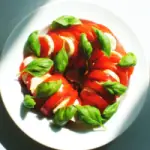 To cut a long story short, we had a long “apperitif” with Jean-Louis and France while we waited for Christine, and then sat down to eat just before 3pm! Fortunately, the Chicken in Salt Crust is a very tolerant recipe that can stand a lot of messing round. We had started it late, so it sat happily in its little salt ‘oven’ while we enjoyed a Tomato and Mozzarella Salad starter (except that I used Feta, for a change!). This is a great starter because it’s fresh, tasty, easy to make and (apart from adding the vinaigrette dressing) can be prepared in advance and kept in the fridge. Be sure to serve some nice fresh chunky bread with it to mop up the dressing… it’s far too good to waste.
To cut a long story short, we had a long “apperitif” with Jean-Louis and France while we waited for Christine, and then sat down to eat just before 3pm! Fortunately, the Chicken in Salt Crust is a very tolerant recipe that can stand a lot of messing round. We had started it late, so it sat happily in its little salt ‘oven’ while we enjoyed a Tomato and Mozzarella Salad starter (except that I used Feta, for a change!). This is a great starter because it’s fresh, tasty, easy to make and (apart from adding the vinaigrette dressing) can be prepared in advance and kept in the fridge. Be sure to serve some nice fresh chunky bread with it to mop up the dressing… it’s far too good to waste.
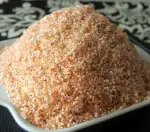 So, at about 3pm, the “bomb” that held the chicken was presented to the table. Of course, it takes a degree in mechanical engineering to open it, so it doesn’t get undressed at the table – it goes back to the kitchen to be exposed and dissected! As it happened, France had never seen one before, so she joined me in the kitchen and attacked the crust with a large, dangerous-looking carving knife.
So, at about 3pm, the “bomb” that held the chicken was presented to the table. Of course, it takes a degree in mechanical engineering to open it, so it doesn’t get undressed at the table – it goes back to the kitchen to be exposed and dissected! As it happened, France had never seen one before, so she joined me in the kitchen and attacked the crust with a large, dangerous-looking carving knife.
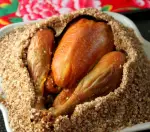 After a few minutes of cursing and hacking, she succeeded in exposing “the beast” and then left me to carve and present it to the other diners! The joy of this dish is that the chicken is “loaded” with Boursin cheese between skin and flesh and this melts to create a really succulent chicken with rich flavours. It might seem like a waste of coarse sea salt, but I can assure you that the end result is well worth it.
After a few minutes of cursing and hacking, she succeeded in exposing “the beast” and then left me to carve and present it to the other diners! The joy of this dish is that the chicken is “loaded” with Boursin cheese between skin and flesh and this melts to create a really succulent chicken with rich flavours. It might seem like a waste of coarse sea salt, but I can assure you that the end result is well worth it.
With the chicken, we served a Ratatouille and, for fun, some “curly potatoes”! M-D discovered a little gadget that drills the inside from vegetables, leaving a core like a spiral of vegetable. So I par-boiled the spirals and then sautéed them. Visually they looked great, and they tasted good too! There was very little left of either the chicken or the vegetables when we had all finished.
Since Jean-Louis and France don’t drink alcohol, there were just three of us sharing the excellent bottle of Pinot Noir that hit the spot nicely for all the courses. After the cheeses, we served Gâteau Creusois and a Carpaccio d’Oranges à la Cannelle (Orange slices with cinnamon) – something we’ve done a couple of times recently (we must stop being lazy and falling back on all the simple recipes!), However, it’s a nice simple, refreshing and tasty way to finish a meal – which just left me loading the dishwasher while the others had coffee and chocolates! – Hmmm – and they say a woman’s work is never done!!
Lovely way to spend a Monday amonst friends!
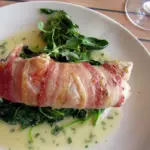 By way of marking our return to France, we invited our friends and neighbours, Terry, Julie, Dominic and Kate to dinner last night. We kicked off in normal style with a glass or two of Kir, using a rather nice Chardonny that had travelled back with us in January. When we settled at the table, we started with
By way of marking our return to France, we invited our friends and neighbours, Terry, Julie, Dominic and Kate to dinner last night. We kicked off in normal style with a glass or two of Kir, using a rather nice Chardonny that had travelled back with us in January. When we settled at the table, we started with 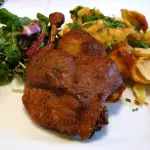 After which, we resorted to one of our regular favourites,
After which, we resorted to one of our regular favourites, 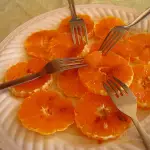 Our dessert was a chocolate and nut gateau that M-D had made using walnuts from her daughter’s garden in The Loire region of France. We served this with orange slices sprinked with orange zest that had been cooked in cinnamon sugar and, just to give a contrast, we mixed normal oranges and blood oranges as we arranged them on the plate. Naturally, there being plenty of chocolate in the cake, we served Mas Amiel with its dense and concentrated inky black Grenache grapes and its complex nose of tobacco and garden herbs.
Our dessert was a chocolate and nut gateau that M-D had made using walnuts from her daughter’s garden in The Loire region of France. We served this with orange slices sprinked with orange zest that had been cooked in cinnamon sugar and, just to give a contrast, we mixed normal oranges and blood oranges as we arranged them on the plate. Naturally, there being plenty of chocolate in the cake, we served Mas Amiel with its dense and concentrated inky black Grenache grapes and its complex nose of tobacco and garden herbs.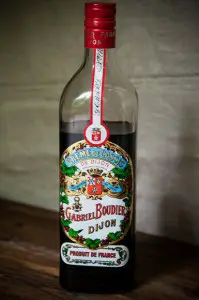 White wine with Crême de Cassis is known as “Kir” in France and is a popular apéritif drink named after Félix Kir (1876–1968), mayor of Dijon in Burgundy, who popularized the drink by offering it at receptions to visiting delegations. Besides treating his international guests well, he was also promoting two vital economic products of the region – blackcurrants and white wine.
White wine with Crême de Cassis is known as “Kir” in France and is a popular apéritif drink named after Félix Kir (1876–1968), mayor of Dijon in Burgundy, who popularized the drink by offering it at receptions to visiting delegations. Besides treating his international guests well, he was also promoting two vital economic products of the region – blackcurrants and white wine.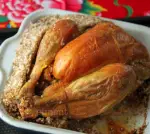 The main course was the “salty” end of the recipe with
The main course was the “salty” end of the recipe with 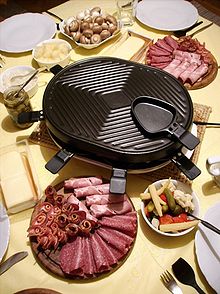 Obviously, we didn’t buy a 50kg block of cheese, light a fire and start scraping it – we used a more modern way of serving raclette that involves an electric table-top grill with small pans, known as coupelles, in which to melt slices of cheese. When we do this, we bring the cheese to the table already cut and sliced, along with a plate of charcuterie like Grisons (which is what we used last night) or pastrami or salami or cooked ham (or whatever floats your boat) accompanied by a big dish of boiled or steamed potatoes and a bowl of cornichons (small gherkins).
Obviously, we didn’t buy a 50kg block of cheese, light a fire and start scraping it – we used a more modern way of serving raclette that involves an electric table-top grill with small pans, known as coupelles, in which to melt slices of cheese. When we do this, we bring the cheese to the table already cut and sliced, along with a plate of charcuterie like Grisons (which is what we used last night) or pastrami or salami or cooked ham (or whatever floats your boat) accompanied by a big dish of boiled or steamed potatoes and a bowl of cornichons (small gherkins).